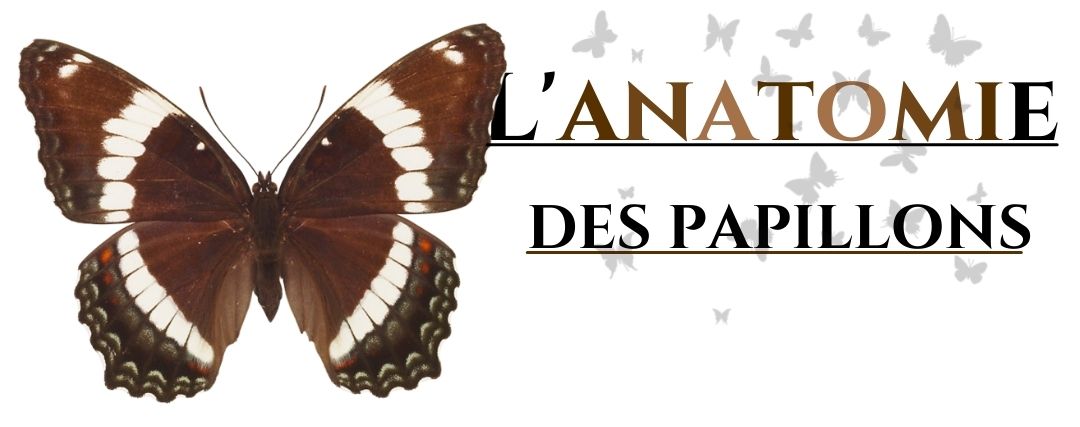In this article, we will explore the various parts of the butterfly's body. It consists of three main sections: the head, which includes the eyes, antennae, and proboscis; the thorax, which is the muscular segment where the legs and wings are attached; and the abdomen, which contains the digestive, respiratory, and reproductive systems.
The Head
Eyes and Vision
Butterflies and most adult insects have spherical compound eyes made up of thousands of individual light receptors called ommatidia. Each ommatidium has its own lens, collectively creating a mosaic view of the surroundings.
Structure
Each ommatidium includes a cornea and a cone that function like a lens. Light passes through these cones to sensory cells sensitive to different parts of the visual spectrum.
Hesperiidae butterflies have unique eyes with gaps between cones and rods, enhancing their resolution and sensitivity, aiding their precise flight. This distinct eye structure classifies them into a different superfamily, Hesperioidea.

Abilities
Optics principles suggest butterflies can see objects clearly from about 1 centimeter to 200 meters due to the short focal length of their ommatidia. Their brain instantly detects light changes, making them highly responsive to movement and capable of measuring the distance of an approaching predator.
This sensitivity, combined with a high flicker frequency of around 150 frames per second, helps butterflies assemble the mosaic image produced by their compound eyes. They have almost 360-degree vision, allowing them to see threats from all directions and also see polarized light, which helps them navigate using the sun even on cloudy days.
Color Perception
Butterflies perceive colors differently from humans and birds, being sensitive to ultraviolet and infrared. Flowers have ultraviolet patterns visible to butterflies, guiding them to nectar like runway lights for airplanes.
Experiments with Colias butterflies show females do not distinguish between males of different colors. Visible patterns primarily serve to protect butterflies by signaling to predators. Butterflies use visual and ultraviolet patterns to identify mates, with iridescent colors aiding in communication.
Shape Perception
Male moths chase any insect resembling a female of their species. However, experiments show they react similarly to various shapes. Females of some species can recognize plants by leaf shape and color, especially monophagous butterflies, while polyphagous butterflies rely more on chemical cues.
Optical Maintenance
Butterflies cannot blink, so they protect their eyes with labial palps, acting as dust filters. Some like the genus Lethe have fine bristles on their eyes, functioning like tactile sensors.
Antennas
Butterflies have a pair of segmented antennae between their eyes, used as olfactory radars to detect pheromones, nectar plants, and for tactile communication. They also "antenna dip" to sample the substrate's chemical qualities.
Differences Between Butterfly and Moth Antennae
Butterfly antennae typically end in a club, while moths' do not, except in some families. Males in certain families have feather-like "pectinate" antennae, highly sensitive to female scents.
Johnston's Organ
At the base of each antenna is Johnston's organ, used to detect orientation and balance during flight. It helps butterflies adjust their direction and detect Earth's magnetic field during migrations.
The Palps
Butterflies have labial palps with olfactory sensors, aiding in detecting food sources and avoiding sticky substances.
Proboscis
Butterflies use a proboscis to suck nectar. It can coil for storage or extend to reach deep flowers. Olfactory sensors on the proboscis and legs allow butterflies to "taste" their environment.

The Thorax
The thorax is made up of 3 body segments with a chitinous cage anchoring the legs and wings. Powerful muscles inside control wing movements. Wing beat rates vary among species.
The Legs
Butterflies generally have 3 pairs of legs, with variations among families. Front legs in some families are reduced or specialized for chemical detection. Middle legs have a subgenual organ to detect vibrations, alerting butterflies to approaching threats. Spurs on legs can pierce leaves to release sap for chemical analysis.
The Abdomen
The abdomen houses the digestive, respiratory, and reproductive systems. The multi-segmented exoskeleton allows flexibility for copulation and egg-laying.
The Spiracles
Spiracles on each segment allow air to enter and exit, enabling the butterfly to breathe through rhythmic body movements.
Digestive System
Butterflies feed exclusively on liquids like nectar and other fluids. Waste is expelled in liquid form or as tiny pellets.
Sexual Organs
The genitals are located at the abdomen's end, with species-specific structures for mating. Females have an ovipositor for egg-laying.
Sound-Generating Organs
Some butterflies and moths produce sounds, often inaudible to humans, for various functions. The Bertholdia trigona moth can jam bat echolocation with ultrasound.

Wings
Venation
Butterflies have two pairs of wings, each composed of a thin double membrane supported by a network of tubular veins. The shape and number of veins are unique to each butterfly genus and are crucial for taxonomic classification.
Scales
The transparent wing membranes are often covered with tiny colored scales. Each scale is a flat plate originating from a single cell on the wing surface. Some genera, like Acraea, Aporia, and Parnassius, have lower scale densities, giving their wings a translucent appearance. Tropical genera like Ithomia and Lamproptera have large transparent areas due to the absence of scales.
There are three main types of scales: pigment scales, structural scales, and androconia.
Pigment Scales
Pigment scales produce the basic colors of butterflies: black, red, yellow, orange, and brown. The juxtaposition of these scales creates the illusion of additional colors. For instance, in Anthocharis cardamines, the green color underneath is an illusion created by the juxtaposition of yellow and black scales. Variations in pigmentation and scale density create textures and shades that give wings a three-dimensional appearance.

Structural Scales
Structural scales produce iridescent colors through patterns of refraction, diffraction, and interference of light. Examples include the fiery hues of the Common Copper (Lycaena), the golden yellow wings of Troides aeacus, and the metallic greens and blues of Morpho butterflies.
Diffraction breaks light into bright bands after passing through microscopic slits within the scales. Refraction fragments light into its constituent colors through prismatic reliefs on the scale surfaces. Interference patterns result from light passing through layers of varying density, causing colors to change with viewing angles.
Examples of iridescence are prominent in butterflies like Doxocopa Emperors and Urania of Madagascar, where colors shift dramatically with changes in light angles due to their unique structural scales.
Androconia
Androconia are mainly found on male butterflies, appearing as slightly raised dark streaks or spots on the front wings. These scales have sacs at their base containing pheromones. The scent is diffused by small hairs, encouraging females to copulate.
Hearing Organs
Some butterflies, including Hamadryas arethusa and Heliconius, can detect sounds using an "ear" located near the base of their wings. This ear, visible under a powerful microscope, is a funnel-shaped sac with a thin membrane that vibrates in response to high-frequency sounds, stimulating nerve cells called scolopidia to send signals to the brain.
Enlarged veins at the base of the forewings in some butterflies also contain ear-like nerve cells. Satyrs, such as Oressinoma and Maniola, react instantly to the sound of leaves being crushed underfoot.
Some butterflies, like Morpho Helenor, can discern high and low frequencies, potentially allowing them to detect wing beats and bird songs, thus evading predators.
The Evolution of Hearing
Butterflies may have initially evolved as nocturnal creatures, using their ears to avoid predatory bats. Bats emit acoustic signals and use their sensitive ears to detect echoes from objects. Moths and butterflies can hear these signals, determining the distance and approach of bats, allowing them to evade capture. High-speed photography shows moths fleeing and then stinging if a bat comes too close.
Flight
The variety of wing shapes and sizes relative to the body creates diverse flight styles. Hesperiidae have short, narrow wings and large bodies, resulting in a buzzing, moth-like flight. Lycaenidae and Riodinidae have broader wings and slender bodies, enabling fast but slower wing beats.
Anaeini butterflies have robust wings, taking off abruptly to disorient predators. Papilionidae have large, light wings for slow, delicate flight. Nymphalidae combine flapping and gliding, creating a parachute effect to slow descent. Neotropical Eurybia and other Riodinidae perch upside down to fly more efficiently.
Thermoregulation
Butterflies are cold-blooded and rely on behavioral strategies to regulate body temperature. In cold weather, they bask in the sun to absorb heat using the upper surface of their wings. Dark wing undersides and heat-reflecting surfaces like stones or tree trunks speed up warming. Males use this method to maintain energy for flight to intercept females.
In hot weather, butterflies seek shade under leaves or bushes, or fly into rabbit burrows. Some, like Marigold, Hipparchia, and Thecla, adjust their wing angles to reduce heat absorption.
Butterflies can also shiver their wings to generate heat. Nymphalidae, like the Day Peacock, Comma, and Vanessa, shiver their wings to warm up enough for short flights. Moths use similar techniques.
The Abdomen
The abdomen contains the butterfly's digestive system, respiratory system, long tubular heart, and reproductive organs. The exoskeleton is multi-segmented, with each of the 10 segments made of chitin, connected by flexible tissue allowing the abdomen to bend, which is essential for copulation and egg-laying.
The Spiracles
On each segment's sides are tiny holes called spiracles, through which air enters and exits the body. Rhythmic body movements coordinated with the spiracles' opening and closing draw air into lung-shaped sacs and then expel it, allowing the butterfly to breathe.
Digestive System
Butterflies feed exclusively on liquids, including nectar, dissolved pollen, mineralized water, liquefied feces, urine, sweat, bodily fluids from decaying animals, and even alligator tears. After digestion, waste is expelled from the anus in liquid form or as tiny fecal pellets.
Sexual Organs
The genitalia are located at the end of the abdomen. Each species has a unique genital structure—the male "key" fits only the corresponding female "lock". This species-specific nature has traditionally been used by taxonomists to determine species and relationships, although DNA analysis and phylogenetics are now also employed.
Females have an ovipositor for releasing and depositing fertilized eggs. In most species, it is short and usually hidden, but in some moths, it is modified into a long tube to insert eggs into tree bark cracks.
Sound-Generating Organs
While insects like cicadas and locusts produce courtship songs, butterflies are usually associated with involuntary sounds such as wing buzzing. However, many butterflies and moths produce sounds serving various functions, often inaudible to humans and detectable only with specialized equipment. Hamadryas butterflies from South America produce a crackling sound by rubbing hollow wing veins. Bertholdia trigona moths can jam bat echolocation with ultrasound using a tympanic organ on their metathorax.

Wings
Venation
Butterflies have two pairs of overlapping wings, each with a thin double membrane supported by tubular veins. The shape and number of veins are unique to each genus and help taxonomists classify butterflies.
Scales
The transparent wing membranes are often covered with tiny colored scales. Each scale originates from a single cell on the wing surface. Some genera, like Acraea, Aporia, and Parnassius, have lower scale densities, making their wings appear translucent. Tropical genera like Ithomia and Lamproptera have large transparent areas due to the absence of scales.
There are three main types of scales: pigment scales, structural scales, and androconia.
Pigment Scales
Pigment scales produce the basic colors of butterflies: black, red, yellow, orange, and brown. The juxtaposition of these scales creates the illusion of additional colors. For instance, in Anthocharis cardamines, the green color underneath is an illusion created by the juxtaposition of yellow and black scales. Variations in pigmentation and scale density create textures and shades that give wings a three-dimensional appearance.

Structural Scales
Structural scales produce iridescent colors through patterns of refraction, diffraction, and interference of light. Examples include the fiery hues of the Common Copper (Lycaena), the golden yellow wings of Troides aeacus, and the metallic greens and blues of Morpho butterflies.
Diffraction breaks light into bright bands after passing through microscopic slits within the scales. Refraction fragments light into its constituent colors through prismatic reliefs on the scale surfaces. Interference patterns result from light passing through layers of varying density, causing colors to change with viewing angles.
Examples of iridescence are prominent in butterflies like Doxocopa Emperors and Urania of Madagascar, where colors shift dramatically with changes in light angles due to their unique structural scales.
Androconia
Androconia are mainly found on male butterflies, appearing as slightly raised dark streaks or spots on the front wings. These scales have sacs at their base containing pheromones. The scent is diffused by small hairs, encouraging females to copulate.
Hearing Organs
Some butterflies, including Hamadryas arethusa and Heliconius, can detect sounds using an "ear" located near the base of their wings. This ear, visible under a powerful microscope, is a funnel-shaped sac with a thin membrane that vibrates in response to high-frequency sounds, stimulating nerve cells called scolopidia to send signals to the brain.
Enlarged veins at the base of the forewings in some butterflies also contain ear-like nerve cells. Satyrs, such as Oressinoma and Maniola, react instantly to the sound of leaves being crushed underfoot.
Some butterflies, like Morpho Helenor, can discern high and low frequencies, potentially allowing them to detect wing beats and bird songs, thus evading predators.
The Evolution of Hearing
Butterflies may have initially evolved as nocturnal creatures, using their ears to avoid predatory bats. Bats emit acoustic signals and use their sensitive ears to detect echoes from objects. Moths and butterflies can hear these signals, determining the distance and approach of bats, allowing them to evade capture. High-speed photography shows moths fleeing and then stinging if a bat comes too close.
Flight
The variety of wing shapes and sizes relative to the body creates diverse flight styles. Hesperiidae have short, narrow wings and large bodies, resulting in a buzzing, moth-like flight. Lycaenidae and Riodinidae have broader wings and slender bodies, enabling fast but slower wing beats.
Anaeini butterflies have robust wings, taking off abruptly to disorient predators. Papilionidae have large, light wings for slow, delicate flight. Nymphalidae combine flapping and gliding, creating a parachute effect to slow descent. Neotropical Eurybia and other Riodinidae often perch upside down under leaves, wings extended, which allows them to take off more efficiently than from an upright position.
Thermoregulation
Butterflies are cold-blooded. If they get too cold, they can't fly; if too hot, they risk dehydration and death. They lack internal temperature regulation and instead use behavioral strategies. In cool weather, butterflies increase body temperature by basking in the sun, using their wings like solar panels to absorb heat. They often position themselves on heat-reflecting surfaces like stones or bare earth to speed up the warming process. Males, in particular, use this method to ensure they can quickly intercept passing females.
In hot weather, butterflies seek shade under leaves or bushes, or enter rabbit burrows to cool down. Species like Marigold (Colias), Hipparchia, and Callophrys fold their wings when perched, adjusting their angle to maximize or minimize sun exposure. Pierids, Azures, and Coppers reflect solar energy more than they absorb it, using their wings' positioning to manage heat retention.
Another method to increase body temperature is shivering. Many Nymphalidae, including the Day Peacock, Comma, and Vanessa species, shiver their wings rapidly to generate enough friction to warm their flight muscles, allowing them to fly even on the coolest days. Moths use similar techniques.
Butterflies must operate within a limited temperature range, so on hot days, they must find ways to stay cool. Forest-dwelling species hide under leaves, while those in open areas seek shade or enter burrows to avoid overheating.





